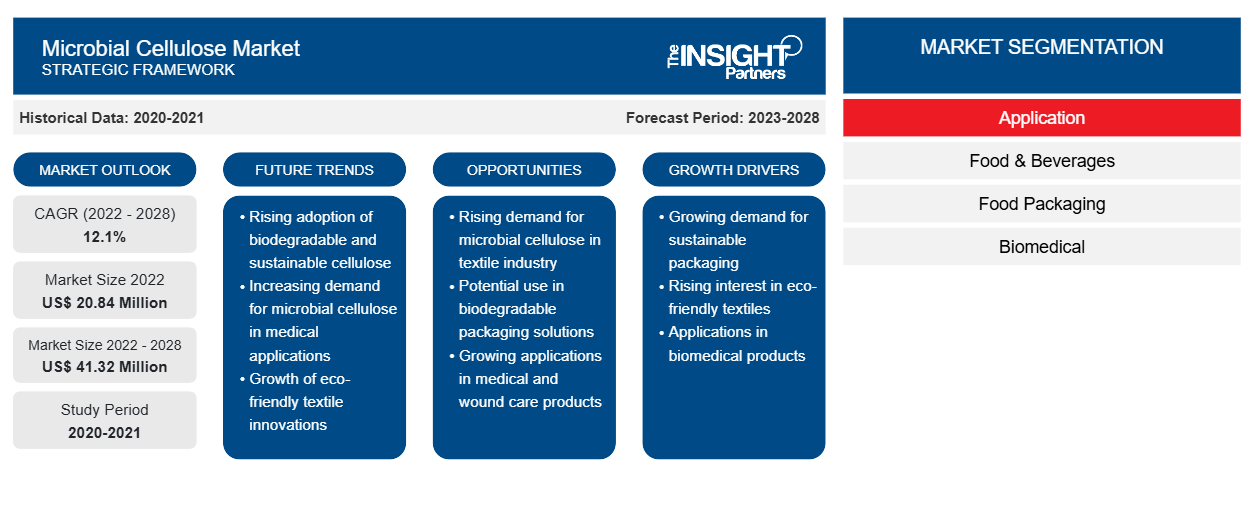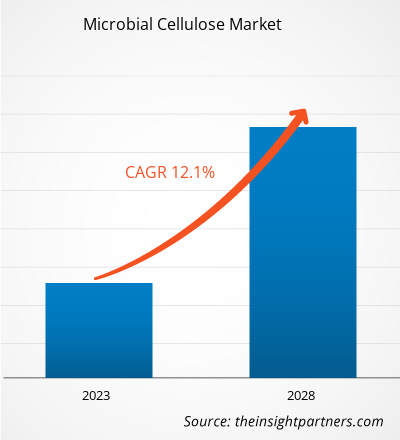[Research Report] The microbial cellulose market size is expected to grow from US$ 20.84 million in 2022 to US$ 41.32 million by 2028; it is estimated to register a CAGR of 12.1% from 2022 to 2028.
Microbial cellulose is produced by the fermentation of culture media rich in glucose and fructose as the main carbon sources. Microbial cellulose has higher tensile strength and water-holding capacity and is biodegradable unlike plant cellulose, which is hard to biodegrade. Bacterial cellulose also has a higher degree of polymerization than plant cellulose, making it highly susceptible to temperature fluctuations, and is free from lignin, hemicellulose, and pectic. Microbial cellulose is gaining immense traction as a biomaterial as it is an eco-friendly alternative to various conventional plastics such as polyethylene and polypropylene. It is also being used in the biomedical industry for wound dressing and medical implants. Thus, various applications of microbial cellulose are driving the global microbial cellulose market growth.
In 2021, Asia Pacific held the largest share of the global microbial cellulose market. In recent years, the region witnessed an upsurge in environmental pollution caused by the manufacturing and improper disposal of cosmetics and personal care products made from raw materials containing toxic substances. As per Frontiers Media S.A. report, in Asia Pacific, over 70% of cosmetics and personal care products contain at least one type of microbe as an ingredient. Thus, the demand for microbial cellulose is increasing in the cosmetic industry in the region. Further, the cosmetics industry in Southeast Asia is growing rapidly due to the increasing purchasing power of the population and rising middle-class population. Thus, all these factors are expected to boost the growth of the microbial cellulose market during the forecast period.
Customize This Report To Suit Your Requirement
You will get customization on any report - free of charge - including parts of this report, or country-level analysis, Excel Data pack, as well as avail great offers and discounts for start-ups & universities
Microbial Cellulose Market: Strategic Insights

-
Get Top Key Market Trends of this report.This FREE sample will include data analysis, ranging from market trends to estimates and forecasts.
Impact of COVID-19 Pandemic on Microbial Cellulose Market
Manufacturing industries, including microbial cellulose companies, faced unprecedented challenges after the emergence of the COVID-19 pandemic in 2020 due to supply chain constraints caused by nationwide lockdowns, trade bans, and travel restrictions. Supply chain disruptions created a shortage of raw materials, which affected the production and distribution of microbial cellulose, leading to increased prices. Further, a spike in medical waste generation globally led to sustainability concerns among consumers, manufacturers, and governments of various countries. There was a significant demand for disposable face masks made of nonbiodegradable material. Thus, manufacturers started exploring different biodegradable biopolymers to make face masks. This factor opened new opportunities for microbial cellulose manufacturers, as microbial cellulose possesses desirable properties to replace conventional materials used in face masks.
In 2021, various economies resumed operations as their governments announced relaxations in the previously imposed restrictions, which boosted the global marketplace. Further, manufacturers were permitted to operate at full capacities, which helped them overcome the demand and supply gap and other repercussions.
Market Insights
Rising Applications in Cosmetics Industry to Fuel Microbial Cellulose Market Growth
Cosmetic manufacturers are exploring innovative approaches and materials to reduce environmental impact. Microbial cellulose is a natural and sustainable material praised by cosmetic manufacturers owing to its biocompatibility, skin adhesion, and water retention properties. Microbial cellulose is majorly used to make sheet masks used in skincare. These masks have superior moisture retention properties owing to their three-dimensional nanostructure that absorbs active hydrophilic ingredients such as antiageing agents and moisturizers. Bio-cellulosic face masks also have strong skin adhesion properties, which helps in better absorption or penetration of nutrients into the skin. Further, people are seeking products that help them look youthful and fresh. They are willing to spend a tremendous amount on skincare products that make their skin healthy-looking and radiant. Sheet masks are getting immense traction among consumers as they help reduce fine lines, wrinkles, acne, and pigmentation; rejuvenate skin; and boost hydration. All these factors are expected to boost the demand for microbial cellulose in the cosmetics industry during the forecast period.
The key players operating in the global microbial cellulose market include ScobyTec GmbH, BOWIL Biotech SP Zoo, Polybion SL, Bacpolyzyme Biyomuhendislik Ltd, Axcelon Biopolymers Corp, Bioweg UG, Cellulose Lab Inc, Bacterial Cellulose Solutions Inc, Ashland Inc, and BIOINSPIRED MATERIALS SL. Market players are focusing on providing high-quality products to fulfill customer demand. They are also focusing on strategies such as investments in research and development activities, partnerships, and expansion.
Microbial Cellulose Market Regional InsightsThe regional trends and factors influencing the Microbial Cellulose Market throughout the forecast period have been thoroughly explained by the analysts at The Insight Partners. This section also discusses Microbial Cellulose Market segments and geography across North America, Europe, Asia Pacific, Middle East and Africa, and South and Central America.
Microbial Cellulose Market Report Scope
| Report Attribute | Details |
|---|---|
| Market size in 2022 | US$ 20.84 Million |
| Market Size by 2028 | US$ 41.32 Million |
| Global CAGR (2022 - 2028) | 12.1% |
| Historical Data | 2020-2021 |
| Forecast period | 2023-2028 |
| Segments Covered |
By Application
|
| Regions and Countries Covered |
North America
|
| Market leaders and key company profiles |
|
Microbial Cellulose Market Players Density: Understanding Its Impact on Business Dynamics
The Microbial Cellulose Market is growing rapidly, driven by increasing end-user demand due to factors such as evolving consumer preferences, technological advancements, and greater awareness of the product's benefits. As demand rises, businesses are expanding their offerings, innovating to meet consumer needs, and capitalizing on emerging trends, which further fuels market growth.

- Get the Microbial Cellulose Market top key players overview
Key Development
In February 2023, Bioweg, a German startup engaged in the production of microbial cellulose, and Ginkgo Bioworks, a company that develops cell programming and biosecurity platforms, signed a partnership agreement to optimize the production of microbial cellulose and develop novel cellulose variants that can substitute conventional plastics.
Report Spotlights
- Progressive industry trends in the microbial cellulose market to help players develop effective long-term strategies
- Business growth strategies adopted by developed and developing countries
- Quantitative analysis of the microbial cellulose market from 2020 to 2028
- Estimation of global demand for microbial cellulose
- PEST analysis to illustrate the political, economic, social, and technological factors impacting the global microbial cellulose market growth.
- Recent developments to understand the competitive market scenario
- Market trends and outlook, as well as factors driving and restraining the growth of the microbial cellulose market
- Assistance in the decision-making process by highlighting market strategies that underpin commercial interest, leading to the market growth
- Microbial cellulose market size at various nodes
- Detailed overview and segmentation of the market, as well as the microbial cellulose industry dynamics
- Size of the microbial cellulose market in various regions with promising growth opportunities
Frequently Asked Questions
What are the opportunities for microbial cellulose market in the global market?
Can you list some of the major players operating in the global microbial cellulose market?
What is the largest region of the global microbial cellulose market?
Based on the application, why does the food and beverage segment have the largest revenue share?
What are the key drivers for the growth of the global microbial cellulose market?
What are the major application areas of microbial cellulose?
- Historical Analysis (2 Years), Base Year, Forecast (7 Years) with CAGR
- PEST and SWOT Analysis
- Market Size Value / Volume - Global, Regional, Country
- Industry and Competitive Landscape
- Excel Dataset
Recent Reports
Related Reports
Testimonials
Reason to Buy
- Informed Decision-Making
- Understanding Market Dynamics
- Competitive Analysis
- Identifying Emerging Markets
- Customer Insights
- Market Forecasts
- Risk Mitigation
- Boosting Operational Efficiency
- Strategic Planning
- Investment Justification
- Tracking Industry Innovations
- Aligning with Regulatory Trends





















 Get Free Sample For
Get Free Sample For